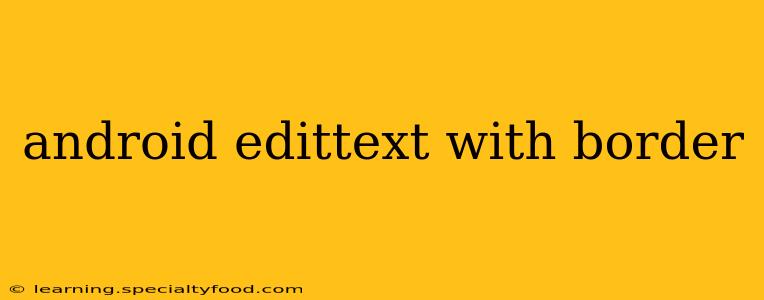Creating an EditText with a border in Android is a common design requirement, enhancing the visual appeal and clarity of your app's user interface. This guide explores various methods to achieve this, catering to different design preferences and levels of customization. We'll cover everything from simple XML attributes to more advanced techniques using custom drawables and styles.
How to Add a Border to an EditText in Android XML?
The simplest way to add a border to an EditText is using XML attributes directly within your layout file. This method is ideal for quick implementations and basic border styles.
<EditText
android:id="@+id/myEditText"
android:layout_width="match_parent"
android:layout_height="wrap_content"
android:layout_margin="16dp"
android:padding="8dp"
android:hint="Enter text here"
android:background="@drawable/edittext_border" />
Here, @drawable/edittext_border refers to a drawable resource you'll need to create. This drawable can be a simple shape with a border, defined in an XML file within your drawable folder (e.g., res/drawable/edittext_border.xml):
<?xml version="1.0" encoding="utf-8"?>
<shape xmlns:android="http://schemas.android.com/apk/res/android"
android:shape="rectangle">
<solid android:color="@android:color/white" /> <!-- Fill color -->
<stroke
android:width="2dp"
android:color="@color/black" /> <!-- Border color and width -->
<corners android:radius="5dp" /> <!-- Optional: Rounded corners -->
</shape>
This code defines a rectangular shape with a white fill, a 2dp black border, and rounded corners with a 5dp radius. Adjust the android:width, android:color, and android:radius attributes to customize your border.
Adding a Border using a Style in Android
For better code reusability and maintainability, consider defining a style for your EditText with a border. This allows you to apply the same border style to multiple EditTexts throughout your app.
Create a style in your styles.xml file (typically located in res/values/styles.xml):
<style name="EditTextWithBorder" parent="Widget.AppCompat.EditText">
<item name="android:background">@drawable/edittext_border</item>
<item name="android:padding">8dp</item>
</style>
Then, apply the style to your EditText in your layout file:
<EditText
android:id="@+id/myEditText"
android:layout_width="match_parent"
android:layout_height="wrap_content"
android:layout_margin="16dp"
android:hint="Enter text here"
style="@style/EditTextWithBorder" />
How to Customize the Border Color and Width?
Customization of the border color and width is easily achieved by modifying the stroke element within your drawable XML file (edittext_border.xml). Simply change the android:color and android:width attributes to your desired values. For example:
<stroke
android:width="3dp"
android:color="@color/myCustomColor" />
Remember to define @color/myCustomColor in your colors.xml file.
How to Create Rounded Corners for the EditText Border?
As shown in the previous examples, rounded corners can be achieved by adding the corners element within the shape drawable:
<corners android:radius="5dp" />
Adjust the android:radius value to control the roundness of the corners. A higher value results in more rounded corners. A value of 0dp creates sharp corners.
Can I Use Different Border Styles (Dashed, Dotted)?
Yes, you can create dashed or dotted borders by using the dashWidth and dashGap attributes within the stroke element. However, this requires a more advanced approach using a shape drawable with a stroke and these attributes. You will need to experiment with the dashWidth and dashGap values to achieve your desired effect. Remember to test this on different Android versions for consistent rendering.
What are the Best Practices for EditText Border Styling?
- Maintain Consistency: Use consistent border styles throughout your app for a cohesive user experience.
- Accessibility: Ensure sufficient contrast between the border color and the background color for accessibility.
- Performance: Avoid overly complex drawables, as they can impact performance, especially on lower-end devices.
- Material Design Guidelines: Adhere to Material Design guidelines for EditText styling to maintain a modern and consistent look.
By following these methods and best practices, you can effectively add visually appealing and functional borders to your Android EditTexts, improving the overall user interface of your application. Remember to test your implementation across different devices and Android versions for optimal compatibility.
